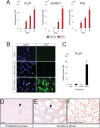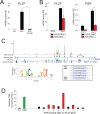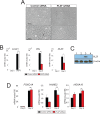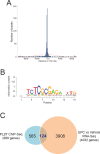The Promyelocytic Leukemia Zinc Finger Transcription Factor Is Critical for Human Endometrial Stromal Cell Decidualization
- PMID: 27035670
- PMCID: PMC4817989
- DOI: 10.1371/journal.pgen.1005937
The Promyelocytic Leukemia Zinc Finger Transcription Factor Is Critical for Human Endometrial Stromal Cell Decidualization
Abstract
Progesterone, via the progesterone receptor (PGR), is essential for endometrial stromal cell decidualization, a cellular transformation event in which stromal fibroblasts differentiate into decidual cells. Uterine decidualization supports embryo implantation and placentation as well as subsequent events, which together ensure a successful pregnancy. Accordingly, impaired decidualization results not only in implantation failure or early fetal miscarriage, but also may lead to potential adverse outcomes in all three pregnancy trimesters. Transcriptional reprogramming on a genome-wide scale underlies progesterone dependent decidualization of the human endometrial stromal cell (hESC). However, identification of the functionally essential signals encoded by these global transcriptional changes remains incomplete. Importantly, this knowledge-gap undercuts future efforts to improve diagnosis and treatment of implantation failure based on a dysfunctional endometrium. By integrating genome-wide datasets derived from decidualization of hESCs in culture, we reveal that the promyelocytic leukemia zinc finger (PLZF) transcription factor is rapidly induced by progesterone and that this induction is indispensable for progesterone-dependent decidualization. Chromatin immunoprecipitation followed by next generation sequencing (ChIP-Seq) identified at least ten progesterone response elements within the PLZF gene, indicating that PLZF may act as a direct target of PGR signaling. The spatiotemporal expression profile for PLZF in both the human and mouse endometrium offers further support for stromal PLZF as a mediator of the progesterone decidual signal. To identify functional targets of PLZF, integration of PLZF ChIP-Seq and RNA Pol II RNA-Seq datasets revealed that the early growth response 1 (EGR1) transcription factor is a PLZF target for which its level of expression must be reduced to enable progesterone dependent hESC decidualization. Apart from furnishing essential insights into the molecular mechanisms by which progesterone drives hESC decidualization, our findings provide a new conceptual framework that could lead to new avenues for diagnosis and/or treatment of adverse reproductive outcomes associated with a dysfunctional uterus.
Conflict of interest statement
The authors have declared that no competing interests exist.
Figures





Similar articles
-
Early growth response 1 transcriptionally primes the human endometrial stromal cell for decidualization.J Steroid Biochem Mol Biol. 2019 May;189:283-290. doi: 10.1016/j.jsbmb.2019.01.021. Epub 2019 Jan 31. J Steroid Biochem Mol Biol. 2019. PMID: 30711473 Free PMC article.
-
Human endometrial stromal cell decidualization requires transcriptional reprogramming by PLZF.Biol Reprod. 2018 Jan 1;98(1):15-27. doi: 10.1093/biolre/iox161. Biol Reprod. 2018. PMID: 29186366 Free PMC article.
-
Establishment of Murine Pregnancy Requires the Promyelocytic Leukemia Zinc Finger Transcription Factor.Int J Mol Sci. 2024 Mar 19;25(6):3451. doi: 10.3390/ijms25063451. Int J Mol Sci. 2024. PMID: 38542422 Free PMC article.
-
Epigenetic modifications working in the decidualization and endometrial receptivity.Cell Mol Life Sci. 2020 Jun;77(11):2091-2101. doi: 10.1007/s00018-019-03395-9. Epub 2019 Dec 7. Cell Mol Life Sci. 2020. PMID: 31813015 Free PMC article. Review.
-
Decidualization of the human endometrial stromal cell: an enigmatic transformation.Reprod Biomed Online. 2003 Sep;7(2):151-61. doi: 10.1016/s1472-6483(10)61745-2. Reprod Biomed Online. 2003. PMID: 14567882 Review.
Cited by
-
Early growth response 1 transcriptionally primes the human endometrial stromal cell for decidualization.J Steroid Biochem Mol Biol. 2019 May;189:283-290. doi: 10.1016/j.jsbmb.2019.01.021. Epub 2019 Jan 31. J Steroid Biochem Mol Biol. 2019. PMID: 30711473 Free PMC article.
-
A Role for Malignant Brain Tumor Domain-Containing Protein 1 in Human Endometrial Stromal Cell Decidualization.Front Cell Dev Biol. 2020 Aug 11;8:745. doi: 10.3389/fcell.2020.00745. eCollection 2020. Front Cell Dev Biol. 2020. PMID: 32850854 Free PMC article.
-
The Long Non-Coding RNA Gene AC027288.3 Plays a Role in Human Endometrial Stromal Fibroblast Decidualization.Cells. 2024 May 2;13(9):778. doi: 10.3390/cells13090778. Cells. 2024. PMID: 38727314 Free PMC article.
-
Negative elongation factor is essential for endometrial function.FASEB J. 2019 Feb;33(2):3010-3023. doi: 10.1096/fj.201801752. Epub 2018 Oct 17. FASEB J. 2019. PMID: 30332301 Free PMC article.
-
Combined analysis of estradiol and β-hCG to predict the early pregnancy outcome of FET: a retrospective study.J Ovarian Res. 2024 Jun 21;17(1):128. doi: 10.1186/s13048-024-01433-0. J Ovarian Res. 2024. PMID: 38907300 Free PMC article.
References
-
- Macklon NS, Geraedts JP, Fauser BC. Conception to ongoing pregnancy: the 'black box' of early pregnancy loss. Human reproduction update. 2002;8(4):333–43. . - PubMed
-
- Zinaman MJ, Clegg ED, Brown CC, O'Connor J, Selevan SG. Estimates of human fertility and pregnancy loss. Fertility and sterility. 1996;65(3):503–9. . - PubMed
Publication types
MeSH terms
Substances
Grants and funding
LinkOut - more resources
Full Text Sources
Other Literature Sources
Research Materials
Miscellaneous

